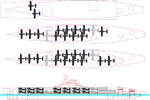Oreo
Senior Airman
24 Fw 190's, any and all of which can be quickly converted to fly any task. All single-seaters. Different armament/ equipment packs available for different tasks. This means you only have to have one type of engine, one type of airframe, and simply have spare parts redundancy and total mission flexability. If US, then they would all be F6F or maybe F4U if it was safe for that type to fly off such a small carrier. British-- I'd rework the landing gear for Seafire to fold inward, and use those exclusively. Japanese didn't have the type of naval fighter bomber I'm talking about, although the N1K series might have been awesome adapted to carriers in 1944! Russian-- La-5 or La-7 derivative. Italian: Re 2002, but need more power. French: Bloch 155 derivative with larger wing.

